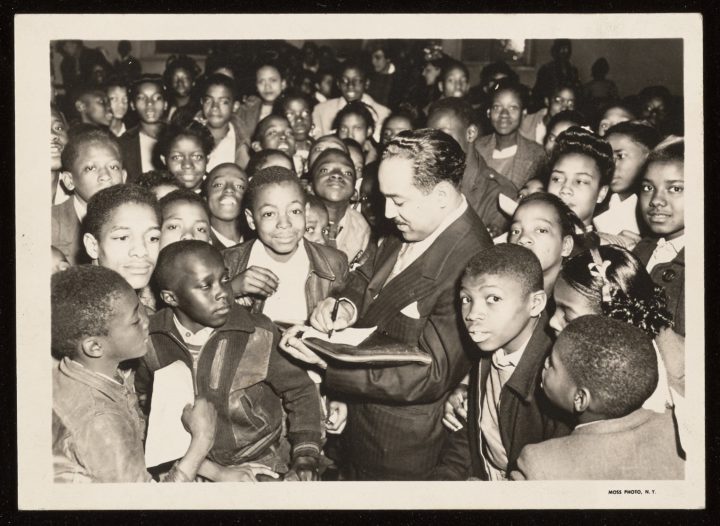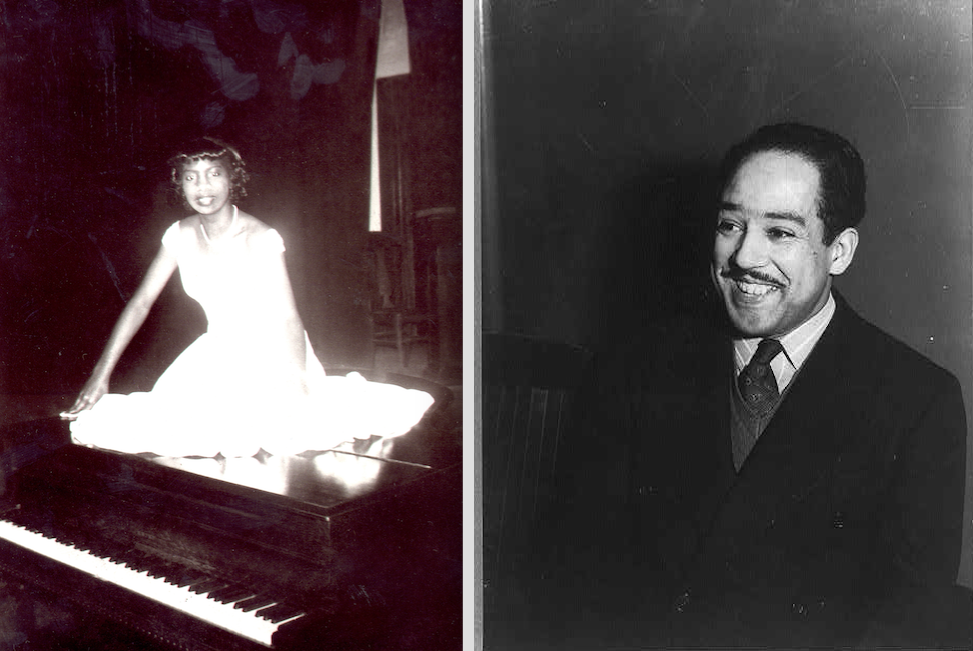When a Raleigh-based audience gasped inside Quail Ridge Books, author W. Jason Miller realized he’d unintentionally discovered his next research topic, ultimately leading him to Western North Carolina.
At the time, Miller, a professor of literature at N.C. State University, was celebrating the February 2020 release of his latest work, Langston Hughes, a biography written for the University of Chicago Press’ Critical Lives series.
Speaking to the audience, “I kind of mentioned off the cuff that Langston Hughes had written a review of this very famous North Carolina musician whose name they might know: Nina Simone.”
Cue the collective gasp.
“I looked out and thought, ‘Oh my gosh, these people are veritably drooling for more information,” the author continues with a laugh. “And so I said to myself, ‘I need to figure out more about what happened between Simone and Hughes.’”
Soon thereafter, Miller launched a new research project, creating an online archive to house rare documents, including audio files and photographs. The growing collection, Backlash Blues: Nina Simone and Langston Hughes, will debut this fall.
In the meantime, Miller and his team of graduate research assistants continue gathering information about Hughes’ historic, albeit underreported, 1949 visit to WNC, where he and Simone first crossed paths.
On Tuesday, Feb. 16, at 6 p.m., Miller will discuss the group’s latest findings as part of a virtual event hosted by Malaprop’s Bookstore/Café. The author says he will also use part of the talk to encourage local residents to share any stories they might have about Hughes’ visit.
Goodbye Jesus
No big headline announced Hughes’ arrival to the mountains in February 1949. His trip was part of a weeklong speaking tour in honor of Negro History Week — the predecessor to Black History Month. The poet was scheduled at a number of locations, including Black Mountain College and Allen High School, a private secondary school for Black women and girls located near downtown Asheville.
After Hughes’ departure, the local paper received a series of letters to the editor. Some residents criticized The Asheville Citizen for failing to report on the historic visit; others applauded the paper’s decision, calling Hughes a communist.
Asheville’s mixed response, explains Miller, was a microcosm of America during this period of McCarthyism and the Red Scare. Hughes had been under the scrutiny of FBI director J. Edgar Hoover for several years leading up to his visit. Hoover declared the writer a communist on account of Hughes’ 1932 trip to the Soviet Union, at which time the poet wrote “Goodbye Jesus.” In the poem’s penultimate verse, Hughes declares:
“Goodbye,
Christ Jesus Lord God Jehova,
Beat it on away from here now.
Make way for a new guy with no religion at all —
A real guy named
Marx Communist Lenin Peasant Stalin Worker ME —”
Because of Hoover’s allegations, Miller points out, several cities boycotted Hughes.
“The Asheville incident is fascinating because you wonder if the newspaper was trying to just practice avoidance by not talking about the event [prior to Hughes’ arrival],” Miller says.
Of greater interest and insight, Miller continues, is Hughes’ written response to local resident Halsey B. Leavitt’s Feb. 20, 1949, letter to the editor, in which Leavitt condemns the poet’s visit and echoes Hoover’s claims. In Hughes’ letter, published in the April 3, 1949, Sunday edition of the Asheville Citizen-Times, Hughes declares:
“I am not now and I have never been a member of the Communist Party. My appearance at the Allen High School was purely in the form of a literary and Negro History Week program. I am sure that the superintendent and principal of Allen High School had in mind, when they invited me to appear at the school, an evening of purely cultural and historical import. Certainly, anyone who was present at the program could hardly have gone away with any other impression. I wish very much that Mr. Halsey B. Leavitt had been present. I thoroughly believe in the right of Mr. Leavitt to present his views to the public. I think that he should accord me the same privilege.”
The poet’s letter, observes Miller, “shows the work Hughes had to do to really defend his reputation.”
Flair, but no air
Eunice Waymon, later known professionally as Nina Simone, was among the students who attended Hughes’ Allen High School address. “She’s literally sitting in the audience, looking up at this famous Black poet that she will eventually become good friends with,” Miller says, still seemingly in awe of the happenstance.

According to Miller, it’s unknown when Hughes first heard Simone’s music. But by 1960, he invited the up-and-coming musician to perform at the summer Newport Jazz Festival. Despite being the third act on the first day, “Simone wowed everybody,” Miller exclaims.
A few months later, in November, Hughes praised Simone’s talents in his weekly column for The Chicago Defender.
“She has a flair, but no air. She has class, but does not wear it on her shoulders. She is unique,” Hughes wrote. “You either like her or you don’t. If you do — wheee-ouuu-eu! You do!”
Over the next seven years, the two artists maintained a written correspondence, until Hughes’ death in 1967.
“He was someone she trusted and relied on,” Miller explains. “At times she wrote him really lengthy letters expressing her true feelings and talked to him about his books and autobiographies.”
Along with their friendship, notes Miller, Hughes also played an important role in several of Simone’s song selections, including “Backlash Blues.” The lyrics originated as a poem that Hughes wrote for the singer shortly before his death. Simone ultimately added her own original verse to the number.
Miller, however, is careful about overstating Hughes’ role in Simone’s career. “Her talent was more than enough on its own,” he says, noting Hughes’ influence simply helped accelerate the singer’s inevitable success.
Lost to the wind
“We have this weird phenomenon in scholarship where music people talk about music people, and poet people talk about poet people,” Miller says, as a way of explaining why this dynamic relationship between Hughes and Simone has been largely ignored in academic circles.
“It’s this huge gap that needs to be filled,” Miller continues, speaking specifically of Hughes and Simone, though the notion extends far beyond the poet and musician.
“African American history and culture has more often been lost to the wind rather than buried in dust because of the oral nature of so many stories passed mouth to mouth,” Miller explains.
Through Backlash Blues: Nina Simone and Langston Hughes, Miller seeks to preserve what he can about the unique friendship between the two artists.
He also views the project as a cautionary tale. “The challenges of recreating the life and times of folks such as Hughes and Simone remind us that so many events and relationships such as these disappear with those who experienced them firsthand,” Miller says. Which is why he implores community members to share with his team whatever recollections, documents, photographs or anecdotes they may have about the unique pair, especially as it relates to Hughes’ 1949 visit to Asheville.
To register for Miller’s Tuesday, Feb. 16, virtual talk, visit avl.mx/8y8. If you have information you’d like to contribute to Backlash Blues: Nina Simone and Langston Hughes, email Miller at wjmille3@ncsu.edu.




It is interesting to learn that Eunice Waymon was a student at the Allen School and of her later friendship with Langston Hughes. I have been fascinated with bits and pieces of Nina Simon’s Childhood at her Tyron NC home which has become a Historical site. Also, I have found references in Lee Smiths’book about the Highland Hospital Fire, Zelda Fitzgerald’s, residency as a patient, and her death in the fire. Smith uses the real name of Mrs. Fitzgerald, Dr. Robert Carol, Director of Highland Hospital, and his wife Grace Potter Carroll, a famed Pianist who works with patients and teaches private students one of the private students is also mentioned by her real name, Eunice Waymon later know as Nina Simone. I believe this is true. Is it?
Hey Barbara! Always good to hear from you. I do not know the answer to this, but I can ask around and I’ll let you know if I find anything out. I hope it’s true–that’s a neat connection. I hope you’re doing well!
Hey Barbara!
According to author and historian Robert O. Sauer, Simone did take lessons from Grace Potter Carroll, as well as from Clemens Sandresky.
Hope you’re doing well!
Hello!
Wonderful article. Do you know what years Simone took lessons from Grace Potter Carroll?
Wonderful article. Thanks.